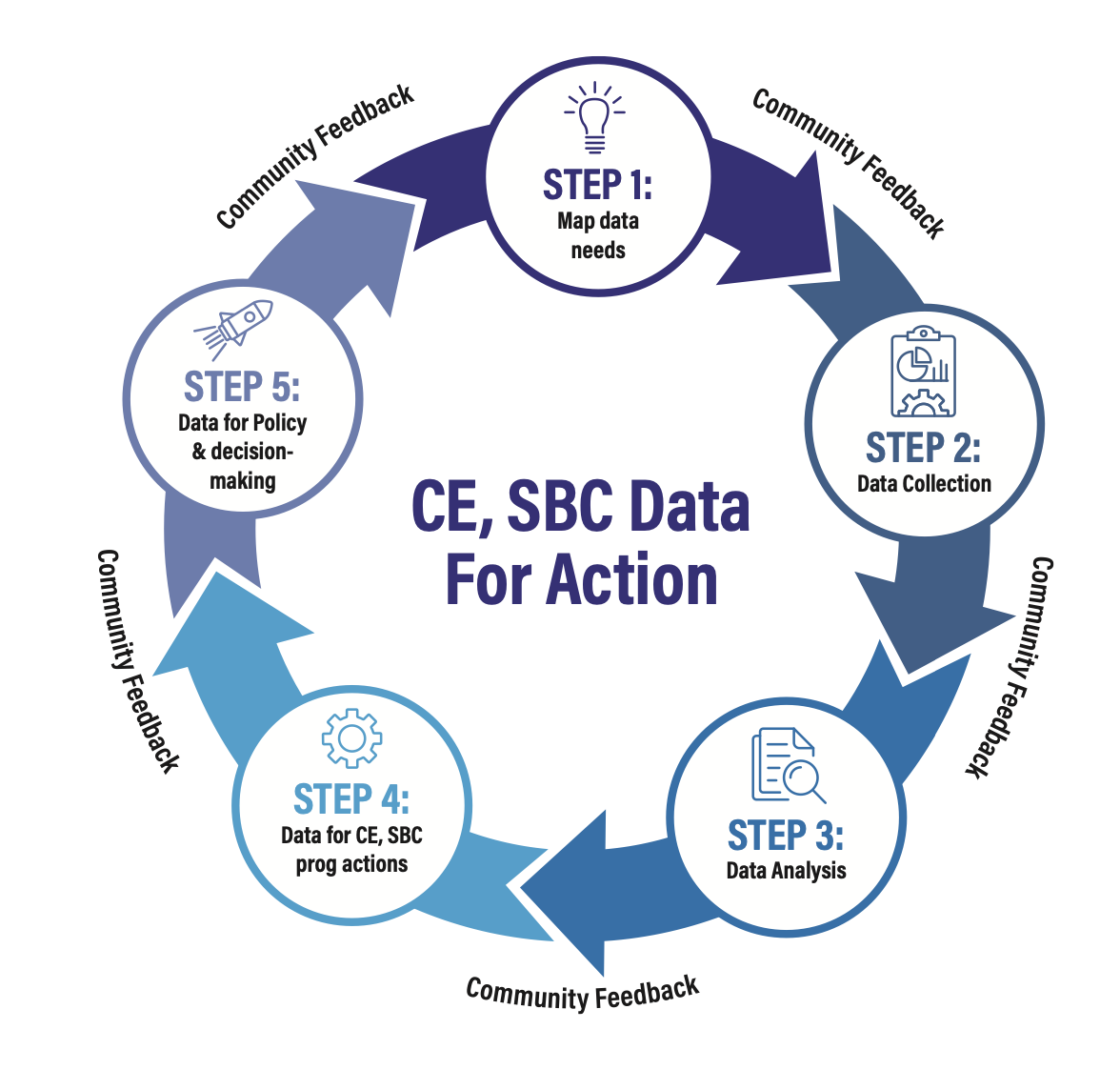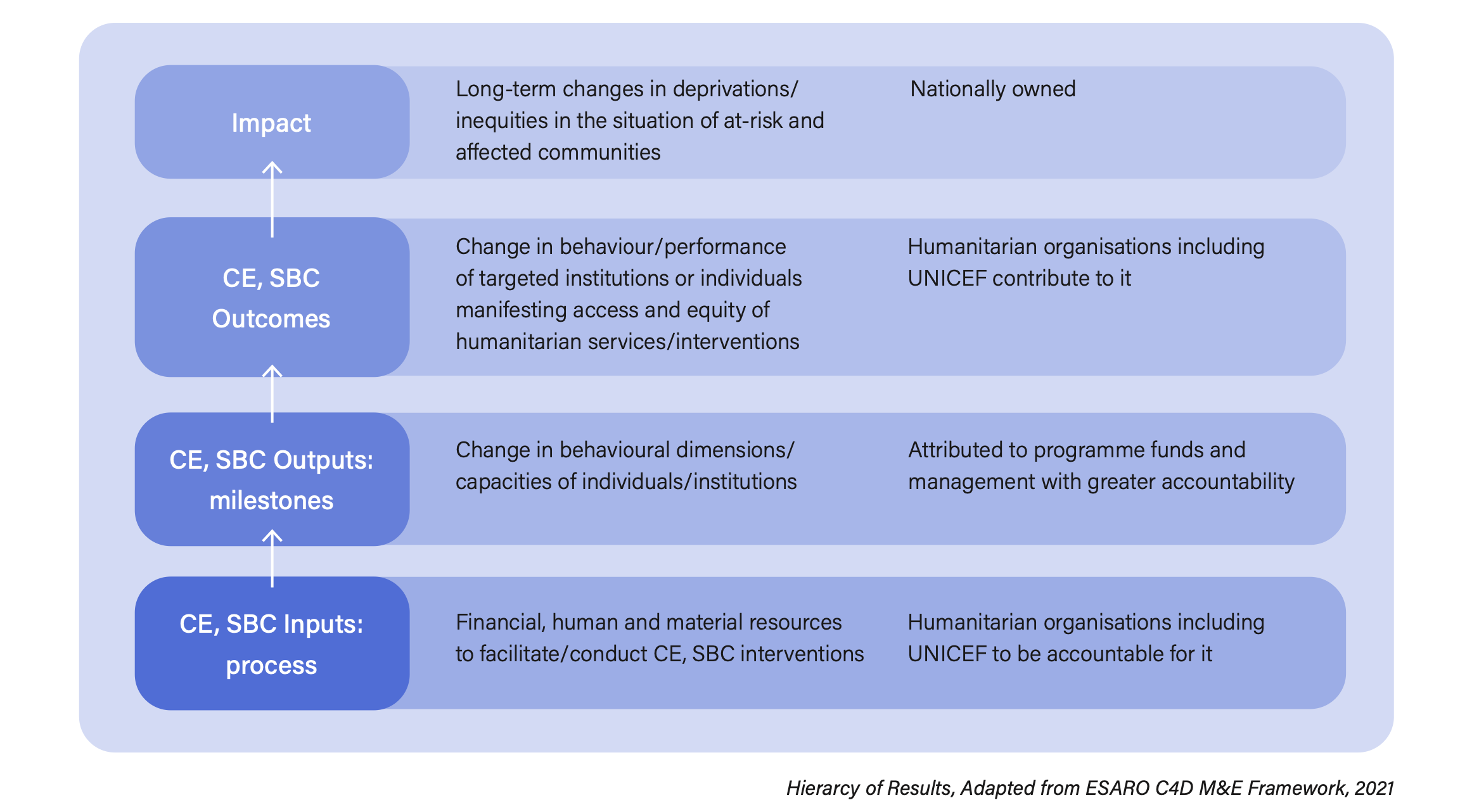
M&E in Emergencies
Measuring change in times of crisis
Introduction
We live in a fast-evolving field of humanitarian action. Natural hazards, conflicts, disease outbreaks, epidemics and complex emergencies require quality Community Engagement (CE) and evidence-informed Social and Behaviour Change (SBC) programming to achieve sectoral results. CE, SBC is an important part of national humanitarian commitments, including results targeted through Humanitarian Response Plans.
People-centred approaches are fundamental to achieving the SDGs and other humanitarian mandates (Grand Bargain Commitments 2.0, Sendai Framework, UN TWIN Resolution for Peacebuilding, Sphere Standards, Core Humanitarian Standards, International Health Regulations).
This guidance presents a set of foundational actions with the potential to advance a measurable people-centred agenda. It guides implementing programmes so that they can engage and empower communities as well as influence attitudes, values and collective actions adapted to specific humanitarian contexts. It further establishes a global yardstick to assess, plan, report and monitor the quality of CE interventions in service of wider SBC programming.
UNICEF, the WHO, the International Federation of Red Cross and Red Crescent Societies (IFRC) are core partners within the Collective Service platform, a global coordination mechanism engaged in global COVID-19 response. The platform aims to deliver structures and mechanisms for a coordinated people-centred approach to risk communication and community engagement (RCCE) across public health, humanitarian and development response. Through consultation and coordination, a global Social and Behavioural Change results framework for COVID-19 response has been developed to strengthen RCCE around six dimensions: information, perceptions, knowledge, practice, social variables and structural variables on the uptake of positive health behaviours
Results-based management for CE, SBC initiatives in humanitarian action
Results-based management (RBM) is a management strategy that emphasizes the achievement of results and their impact. It involves analysing the context to better plan and prioritize actions, implementing a plan, monitoring and evaluating results to adjust the plan. Then the cycle begins again, gradually approaching more ambitious outcomes, as shown in the figure below.

- Evidence from different humanitarian contexts has repeatedly shown that providing individuals, families and communities with the right information alone rarely translates into optimal decision-making. Affected communities and vulnerable groups are influenced by their environment, the people who matter to them and the people they interact with. CE, SBC strategies and interventions that focus merely on reaching communities with messages and increasing their knowledge and awareness of certain practices tend to be ineffective without support from other interventions.
- For humanitarian programmes to achieve social and behavioural results, there must be evidence-generation activities related to CE, SBC to inform humanitarian actions. These activities should support the achievement of behavioural outcomes, such as service-seeking behaviours and protective practices. Prioritizing behavioural determinants and factors is instrumental in developing humanitarian programmes and creating robust mechanisms to collect, analyse and use quantitative and qualitative data is critical in humanitarian contexts. Instead of capturing immediate activity-level data, which current results tend to focus on, SBC measurement should focus on long-term sustained engagement and resources to achieve results.
- For any given crisis, RBM-based CE, SBC programming should align with Country Humanitarian Response Plans (HRPs) or Humanitarian Programme Cycles (HPC). These include context and situation analysis to identify key drivers of a specific behaviour or practice. Strategic prioritization and planning will help to define key objectives and interventions for implementation. Indicators developed around key objectives will be monitored through a baseline and regular evidence-generation activities throughout the course of a programme.
Measuring with quality
A quality CE, SBC programme should be guided by a comprehensive results framework and M&E plan. Measurement must be guided by a hierarchy of CE, SBC results including impact, outcomes, outputs/milestones and inputs/process monitoring.

Consider the following when formulating results:
- Clarity regarding the level of measurement: Output, outcome or impact
- Accountabilities: Who is responsible for collecting, analysing, reporting and using data. CE, SBC systems should be led by government institutions or supported by Humanitarian Coordination Committees when governments have limited function
- SMARTER results: Strategic, Measurable, Aligned, Realistic, Transformative, Empowering, Reportable
- Coherent result chains: Clear links between the achievement of results at multiple levels
- The use of change language: The subject of change should be emphasized
- Leave no one behind: Focus on equity, human rights, gender, determinants and risks
- Clear relationship with issues identified in the SitAn: Results should be relevant to local context and based on up-to-date evidence and analysis
Quantifying the measurable: CE, SBC initiatives in humanitarian action
All humanitarian programmes must include CE, SBC that engage and encourage participation from members of affected and at-risk communities. A set of quality CE, SBC benchmarks and indicators have been developed to measure the quality of community engagement programmes and interventions across humanitarian contexts. The first of its kind, this set of benchmarks and indicators are both quantitative and qualitative, and include additional information from detailed sectoral data and situation reports.
There are two indicators to ensure quality CE, SBC in humanitarian action:
Institutionalization of Community Engagement mechanisms:
UNICEF and other humanitarian actors help countries institutionalize CE mechanisms for participatory planning, implementation and monitoring. Mechanisms can be government or community led, and should facilitate social accountability and accountability to affected populations. Through consistent advocacy and support, these mechanisms can be integrated and normalized within humanitarian organizations and in their national institutions (sectoral and disaster management authorities). This increases their scale and sustainability, which allows for increased ownership and accountability from national stakeholders. The institutionalization of CE mechanisms is supported through the following quality benchmarks:
- CE, SBC coordination mechanism(s) at national and sub-national/local levels that work together to advance a people-centred agenda
- CE, SBC budgeting and human resourcing, to facilitate institutionalization in national programmes and plans
- Two-way community engagement mechanisms and feedback
- Wide-scale community engagement and participation in planning, monitoring, feedback and accountability, especially with marginalized and underserved populations
These benchmarks enable countries to report and track progress on building/strengthening systems, based on guidance outlined through CE minimum standards.
Core Commitments for Children in Humanitarian Action:
The CCCs are part of UNICEF’s core policy and framework for humanitarian action. Grounded in global humanitarian norms and standards, the CCCs provide mandatory sectoral and cross-sectoral strategic results for coverage, quality and equity during humanitarian action and advocacy undertaken by UNICEF and partners. CE, SBC is now an integral part of the CCCs’ commitments and benchmarks, guiding the selection of indicators and targets included in country preparedness and response plans. This enables better measurement and reporting on the performance of UNICEF and its partners. Indicators at outcome and output level are provided for the following sectors and cross-cutting priorities:
- Health
- Nutrition
- WASH
- Education
- Child Protection
- HIV
- CE, SBC
- Social Protection
- Public Health Emergencies/RCCE
- Gender Equality
- Accountability to Affected Populations (AAP)
- Disability
- Adolescent Development and Participation
Each sector and cross-sectoral area under the CCCs has a set of core quantifiable indicators based on CE, SBC commitments. Each indicator includes guidance at outcome and output level to track the quality of CE programmes implemented for emergencies and SBC attained throughout the emergency and development programming.
Meta-guidance for measuring indicators in CCCs
Use a mixed-method approach to collect and report on CCC indicators. Data collection should align with existing humanitarian data systems followed by sectors or national institutions. Consult with sectors (or clusters) to decide which indicator to adopt and how the different data sets are used. Data may be presented through complete enumeration, including the entire target population, or through sampling, where information from a representative sample is extrapolated to the entire group.
Implementation stages
Each implementation stage must align CE, SBC actions to the Humanitarian Programme Cycle (HPC) and contribute to a country’s Humanitarian Response Plans (HRPs). All CE, SBC policies, strategies and programmes should adopt a community-led and people-centred perspective that considers social data, co-creation, participation and accountability.
HPC stage | CE, SBC actions in HPC |
Steps | Roles and responsibilities |
Stage 1: Emergency preparedness for response | CE, SBC preparedness for response | Establish a CE, SBC M&E system: Time constraints, limited resources and panic all affect the ability of humanitarian actors to respond to emergencies in an effective and timely manner. As part of CE, SBC preparedness, M&E systems must support activities through all phases of HPC. Key actions: i. Identify partners for M&E ii. Define coordination mechanisms, roles and responsibilities for M&E, should an emergency occur. Establish reporting structures/feedback loops that enable regular communication between national and sub-national levels. iii. Validate outcome/output-level indicators and reporting forms to assist with initial monitoring, where known emergencies are likely to occur. These must be adjustable based on the nature of the crisis. | Programme staff collaboration with partners including humanitarian actors, national institutions and academia |
Stage 2: Needs assessment
| Social data for action | Conduct CE, SBC analysis as part of country risk analysis: Conduct systematic mapping and assessment of needs, vulnerabilities and behavioural gaps of the at-risk and affected populations. Include operational problems and underlying causes, as well as an assessment of capacities, resources and gaps of implementing organizations to inform CE, SBC strategies for sector/cross programmes | Civil society organizations and research institutions, in collaboration with programme staff and national institutions |
Stage 3: Strategic response planning
| CE, SBC strategic response plan & implementation | Formulate CE, SBC results to inform HRP objectives: Identify and prioritize expected results that contribute to agreed HRP objectives and programmes, processes and financial/human resources. Prioritize results to address gaps in UNICEF and humanitarian organizations, as part of CE, SBC programmes. Use established results and interventions to build synergy and a shared vision while leveraging areas of mutual benefit with organizations, groups and individuals who maintain active interest in CE, SBC programming for humanitarian action. | Humanitarian organizations in collaboration with clusters/sectors |
Stage 4: Implementation and monitoring
| Monitoring, evaluation and learning
| Engage in CE monitoring, evaluation and learning: Align ongoing monitoring, performance and impact assessment, with standards and indicators to track whether interventions have the desired impact and are proceeding according to the CE, SBC plan. Use these findings to make systematic adjustments to CE, SBC interventions and programmes, targeted groups, costs, etc. Integrate key insights into future planning. . | Programme staff collaboration with partners including humanitarian actors, national institutions and academia |
Stage 5: Operational peer review & evaluation | Help humanitarian organizations remain accountable to communities, by continuing to collect continuous feedback from affected and at-risk communities. |
Partnerships
Partnerships should:
- Plan and budget the M&E component for CE, SBC across the HPC, based on the country context. This will ensure that these processes are in place before the onset of a humanitarian crisis. M&E should focus on developing a common vision among partners with flexible systems that can adjust to the changing context and available resources.
- Use existing CE, SBC coordination mechanisms (within the specific context )for M&E activities. Coordinate with cluster-supported mechanisms to inform sectoral commitments and accountability.
- Coordinate with all key stakeholders facilitating results-based programming for CE, SBC early on in the preparedness and planning process. Clarify roles for M&E personnel, research and programme staff from humanitarian organizations and government institutions with respect to data collection, analysis and use. All relevant stakeholders must be included to facilitate results-based programming for CE, SBC.
Government: National and sub-national/local institutions especially supporting sector interventions and Disaster Management Authorities | Community-led organizations: INGOs, NGOs, CSOs, private sector
| Academic institutions or professional academic networks/associations |
Key resources
- Community Engagement Minimum Standards
- Meta-guidance and indicators for CCCs
- How to formulate SBCC results and indicators (page 18-23, Measuring Results in SBC Communication Programming)
- SBC in the Humanitarian Cycle: Using the Community Engagement in Humanitarian Action Toolkit (CHAT)
- COVID-19 RCCE M&E Guidance, Collective Service

Do - M&E in Emergencies
Download this article as a PDF
You can download the entire page as a PDF here






